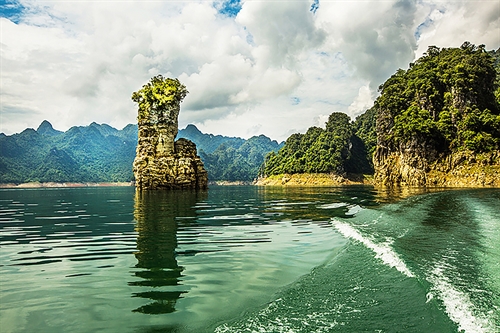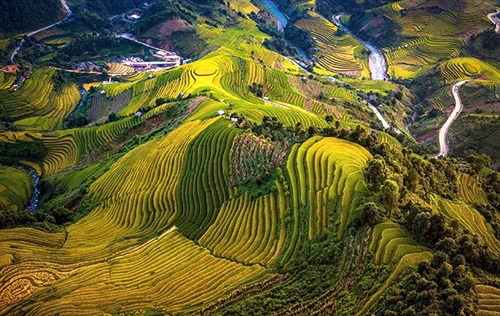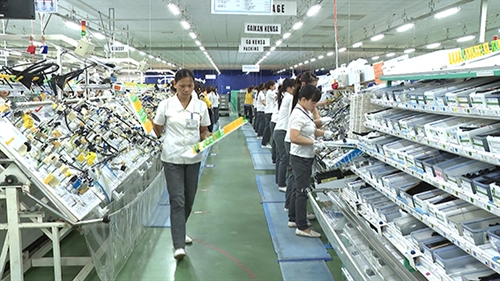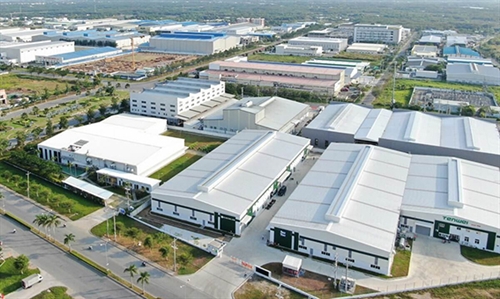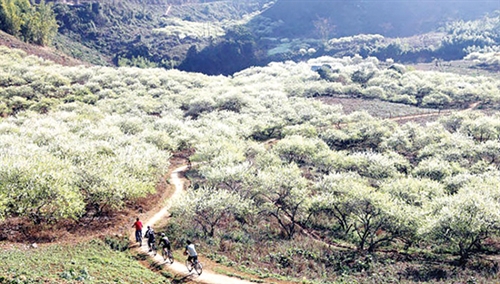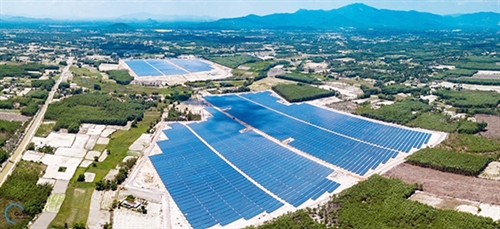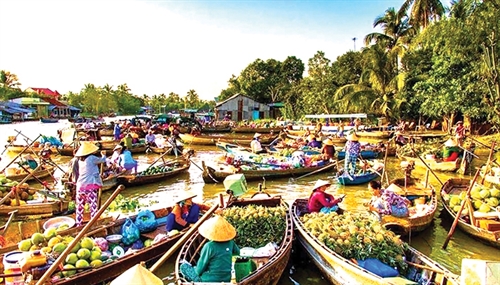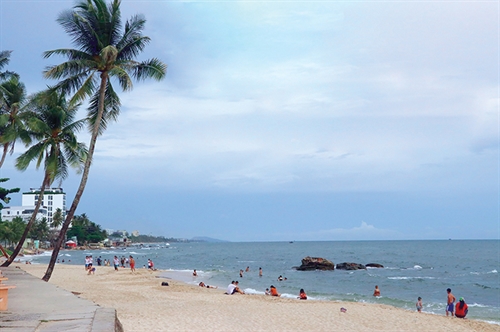Ha Giang, Vietnam’s northernmost province, that shares a border of 277.5 kilometers with China, is calling for investment in tourism develoment, aiming to make tourism a key economic sector by 2025 with the province’s natural resources and ethnic cultural identities.
Ha Giang is bordered by Cao Bang province in the east; Lao Cai and Yen Bai provinces in the west, Tuyen Quang province in the south; and China’s Yunnan and Guangxi provinces in the north.
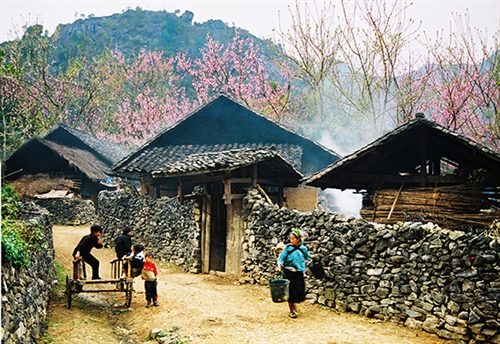 |
| Spring in Dong Van Karst Plateau, Ha Giang province__Photo: VNA |
Ha Giang’s complex topography is divided into three areas. The northern part including Meo Vac, Dong Van, Yen Minh and Quan Ba districts is covered with steep limestone mountain ranges and deep canyons separated by rivers where such fruit trees as plump, peach, pear, persimmon and apple are grown. The western part including Xin Man and Hoang Su Phi districts, a number of communes of Bac Quang and Quang Binh provinces, and Vi Xuyen district on Tay Con Linh mountain range has dazzling high passes, sloping mountainsides, gorges and narrow streams. Its climate is ideal for keeping honey bees and growing ancient shan tuyet tea trees. The lowland areas stretch across the provincial city with the same name and Bac Me district and some parts of Vi Xuyen, Bac Quang and Quang Binh districts are considered the province’s impetus economic region. They have hills and the valley of Lo river which flows through the province from Yunnan province and are home to citrus fruit trees, including orange.
The province wishes to attract investors with financial capacity that apply modern and environmentally friendly technologies, particularly investors from the State Parties to the Association of the Southeast Asian Nations (ASEAN), Comprehensive and Progressive Agreement for Trans-Pacific Partnership (CPTPP) and the European Union-Vietnam Free Trade Agreement (EVFTA).
The provincial authorities have offered specific support to domestic and foreign investors to develop tourism projects and infrastructure facilities. In addition to special investment incentives offered by the Law on Investment, tourism investors will be entitled to corporate income tax exemption for the first four years and 50-percent reduction of payable tax amounts for the next nine years. Investors will also enjoy land rental exemption for three years during capital construction and for 11 years of the project implementation. Provincial authorities will provide support to investors in paying expenses for ground clearance and building tourist accommodations and restaurants up to tourism service standards.
Thanks to the province’s constant efforts to improve its local investment environment, Ha Giang climbed 13 places to 27th in the 2020 Provincial Competitiveness Index (PCI) ranking. It has also improved the 2020 Provincial Governance and Public Administration Performance Index (PAPI) rankings by jumping to 33rd, up two places from 2019.
Its public administration reform index (PAR Index) ranked 33rd nationwide, up 20 places from 2019, while its satisfaction index of public administration services (SIPAS) increased by 10 ranks to the 25th places.
Director Luong Van Doan of the Ha Giang Department of Planning and Investment told the Vietnam Law and Legal Forum magazine that the province has only six foreign direct investment (FDI) projects worth USD 4.15 million in total.
During 2011-22, Ha Giang implemented 85 non-governmental organization projects and programs worth VND 489.284 billion (USD 21.5 million).
Ha Giang province has considered prosperity and success of investors a measurement of its dynamism and development. The province has applied investment incentive policies, reformed administrative formalities, improved investment and business climate and supported business development so as to attract investment in the province’s three socio-economic development pillars - commercial agriculture, tourism and cross-border trade.
The province has established a steering committee for implementation of its action programs, improved its PCI and hosted the monthly “Entrepreneurs’ Coffee Talks” to provide information, exchange and share business experiences and remove obstacles for businesses in the province. It has also implemented the single-window mechanism to process administrative procedures concerning business registration, investment registration, tax, land, and settlement of complaints of citizens and business community. The provincial administration has provided support in labor training, reviewed issued legal documents before proposing amendments, modifications, annulment or cancellation thereof in order to save time and expenses for processing of administrative formalities while ensuring publicity and transparency and increasing administrative agencies’ responsibility.
| * Provincial facts Land area: 7,929.5 sq.km Average altitude of the land (above the sea level): 800-1,200m Administrative units: Ha Giang city and 10 districts of Quang Binh, Dong Van, Meo Vac, Yen Minh, Quan Ba, Vi Xuyen, Bac Me, Hoang Su Phi, Xin Man, Bac Quang Population: 877,888 (the 2020 statistics) Ethnic groups: 19 ethnic minority groups make up 87.7 percent of the province’s population, mainly H’Mong (34.46 percent), Tay (22.43 percent), Dao (14.82 percent), and five small ethnic groups of Pu Peo, Bo Y, Co Lao, Lo Lo and Pa Then. The Kinh (Viet) accounts for only 12.30 percent. Socio-economic figures: - The rate of poor households: 18.54 percent (ranked second among seven provinces with the highest poverty rate in 2021) - Cross-border trade value: USD 485.1 million (in 2021) - Economic growth rate: 5.06 percent (in 2021) - Farm products bearing geographical indications:
- Famous tourist attractions:
- Community-based cultural and tourism villages: 35 - Festivals:
|
The province has worked out a tourism development strategy that focuses on three key tourist areas aimed at welcoming 3 million tourists and earning VND 7.8 trillion (some USD 340 million) by 2025. The key tourist areas include the low-hill tourism space covering Ha Giang city and Bac Me, Vi Xuyen and Bac Quang districts with agriculture-based and cultural, ecological and spiritual tourism products; the northern limestone hill tourism in the Dong Van Karst Plateau covering Quan Ba, Yen Minh, Dong Van and Meo Vac districts with cultural, ecological and adventure tourism products; and the southwestern hilly tourism in Hoang Su Phi, Xin Man and Quang Binh districts with ecological, community-based and recreational tourism products.
Deputy Director Nguyen Thi Hoai of the Ha Giang Department of Culture, Sports and Tourism said the province has planned to develop many new types of tourism and tourism products, including new cultural tourism products that introduce festivals of ethnic minority groups and hot air balloon festivals.
“Adventure tourism products include paragliding in terraced rice fields, joining mountain marathons, boating on Nho Que river and walking on white cliffs,” she said.
In addition, Ha Giang has planned to offer border-trade tours and build several shopping centers to introduce local agricultural products.
Vice Chairman Nguyen Le Phuc of the Vietnam National Administration of Tourism has suggested Ha Giang province exploit the potential of culture and well-known spectacular sceneries to create positive impacts on local socio-economic development and improve livelihood and generate jobs for locals in the development of sustainable tourism.
“The province should continue to improve mechanisms and policies for planning, human resource training and communication and engage local people, particularly ethnic minority people, in protecting environmental resources and providing tourism services,” Phuc said.
At present, Ha Giang province is one of the top 10 pioneers in the country in tourism development through diverse digital marketing channels.
Since the outbreak of the COVID-19 pandemic in the country, a number of programs depicting landscapes, culture and cuisine of the locality have been held on digital platforms. Worthy of note is the tourism program called Qua Nhung Mien Di San Ruong Bac Thang (Traveling through the Heritage Terraced Fields) in Hoang Su Phi district; and the Ha Giang buckwheat flower festival themed Hoa cua da (Flowers of Karst) featuring buckwheat flowers on the Dong Van Karst Plateau, a UNESCO Global Geopark.
The Ha Giang Department of Culture, Sports and Tourism said the province welcomed around 86,000 tourists, earning a turnover of some VND 160 billion (USD 6.9 million) in the first nine days of the first lunar month of the new year, the Year of the Tiger.
Emer Handly, a tourist from Ireland who travelled to Ha Giang on the fourth day of the first lunar month for a three-day “Ha Giang loop” tour, told the Vietnam Law and Legal Forum magazine that: “It is one of the most beautiful places in Vietnam. We got a bit unlucky with the weather but the landscape was still gorgeous.”
US teammate Stephanie Pollock, who was in the same tour group, said she was impressed by the province’s rolling hills, unique rock formations and winding roads.
“Incredible colors, fabrics from velvet to linen, patterns from floral to stripes, and details of embroidery and sequins - the clothing of the local ethnic minorities is truly amazing to see,” she said.-
